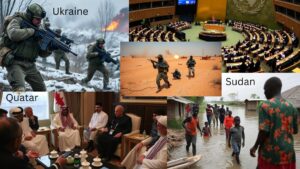The Union of Soviet Socialist Republics (USSR) was one of the two superpowers during the Cold War, the other being the United States of America. The USSR was a federal socialist state made up of 15 republics, each with its own distinct government and language. The Communist Party of the Soviet Union (CPSU) was the sole political party in the country, and it held complete control over the government and the economy.
The head of state of the USSR was the General Secretary of the CPSU, who held significant power in the government and military. The position was held by several leaders during the Cold War, including Joseph Stalin, Nikita Khrushchev, Leonid Brezhnev, and Mikhail Gorbachev.
The Soviet government was divided into three branches: the legislative, executive, and judicial. The Supreme Soviet was the highest legislative body and was composed of two chambers – the Soviet of the Union and the Soviet of Nationalities. The executive branch was headed by the Council of Ministers, which was responsible for implementing laws and policies. The judicial branch was responsible for interpreting and enforcing the law in the country.
The Soviet economy was centrally planned and controlled by the government. The state was responsible for owning and managing most industries, including energy, transportation, and agriculture. This led to a lack of competition and innovation, resulting in a stagnant economy and a shortage of consumer goods.
The USSR’s foreign policy during the Cold War was focused on spreading communism and enhancing its sphere of influence. The country supported communist movements and governments in other countries and engaged in proxy wars in places like Korea, Vietnam, and Afghanistan. The USSR also maintained a close relationship with Eastern European countries that were under its control, such as East Germany, Poland, and Czechoslovakia.
During the Cold War, tensions between the US and the USSR reached a peak, with both countries engaging in a nuclear arms race. This led to the creation of complex diplomatic agreements, such as détente, and arms control agreements, such as the Strategic Arms Limitation Talks (SALT) and the Anti-Ballistic Missile Treaty.
In conclusion, the USSR during the Cold War was a federal socialist state with a single-party government and a centrally planned economy. Its foreign policy focused on spreading communism and expanding its sphere of influence. While the USSR was a superpower during the Cold War, its economy was stagnating, and its military might could not keep up with the US. The USSR ultimately collapsed in 1991, leading to the end of the Cold War.
 Ethereum Classic ETC: Navigating a Critical October with Steady Technical Outlook and Growing Ecosystem News
Ethereum Classic ETC: Navigating a Critical October with Steady Technical Outlook and Growing Ecosystem News
 Mantle (MNT) Hits New Highs: Market Analysis and Future Outlook
Mantle (MNT) Hits New Highs: Market Analysis and Future Outlook
 Ethena (ENA) on the Rise: Technical Signals and Strategic Investments Fuel Growth
Ethena (ENA) on the Rise: Technical Signals and Strategic Investments Fuel Growth
 Aave Gathers Bullish Momentum: Technical Insight and Latest DeFi Milestones
Aave Gathers Bullish Momentum: Technical Insight and Latest DeFi Milestones
 Is Bitget Token (BGB) Set to Surge? October 2025 Price Trends and Technical Signals
Is Bitget Token (BGB) Set to Surge? October 2025 Price Trends and Technical Signals
 Toncoin (TON) Holds Steady Amid Volatility, Backed by Strong Fundamentals and New Developments
Toncoin (TON) Holds Steady Amid Volatility, Backed by Strong Fundamentals and New Developments
 Cronos (CRO) Faces Critical Support as Market Volatility and Upbeat News Shape Outlook
Cronos (CRO) Faces Critical Support as Market Volatility and Upbeat News Shape Outlook
 Sui’s Native Stablecoins Ignite Momentum as Price Eyes Key Support Zones
Sui’s Native Stablecoins Ignite Momentum as Price Eyes Key Support Zones
 Hyperliquid (HYPE) Price Surge: Strong Momentum Amidst Unlock Risks and Whale Activity
Hyperliquid (HYPE) Price Surge: Strong Momentum Amidst Unlock Risks and Whale Activity
 Resurrecting the Extinct: How Science is Bringing Back Mammoths, Dire Wolves, and More
Resurrecting the Extinct: How Science is Bringing Back Mammoths, Dire Wolves, and More
 Romania is becoming a POLICE STATE – they take your DNA without active sentence- September 30, 2025
Romania is becoming a POLICE STATE – they take your DNA without active sentence- September 30, 2025
 Ship Goo Discovery: Scientists Find New Life Form in a Vessel’s Rudder
Ship Goo Discovery: Scientists Find New Life Form in a Vessel’s Rudder
 Stablecoins Surge Amid Shifting Regulatory Landscape and Market Growth
Stablecoins Surge Amid Shifting Regulatory Landscape and Market Growth
 Solana’s Steady Pulse Amid Volatility: Price Anchored by Upgrades and Growing Institutional Interest
Solana’s Steady Pulse Amid Volatility: Price Anchored by Upgrades and Growing Institutional Interest
 Uniswap’s UNI Faces Critical Tests with Upgrades Lighting the Path Ahead
Uniswap’s UNI Faces Critical Tests with Upgrades Lighting the Path Ahead
 Chainlink: Strength Amidst Market Dips and a Promising Outlook 28 September 2025
Chainlink: Strength Amidst Market Dips and a Promising Outlook 28 September 2025
 The 2025 Comet Parade: A Rare Cosmic Traffic Jam
The 2025 Comet Parade: A Rare Cosmic Traffic Jam
 TRX at a Turning Point: Technical Signals and Ecosystem Expansion Drive Market Outlook
TRX at a Turning Point: Technical Signals and Ecosystem Expansion Drive Market Outlook
 Bitcoin SV at a Crossroads: Technical Signals and Market Developments Shape Its Next Move
Bitcoin SV at a Crossroads: Technical Signals and Market Developments Shape Its Next Move
 Polygon’s Rise as a Multi-Chain Leader: Technical Insights and Market Momentum
Polygon’s Rise as a Multi-Chain Leader: Technical Insights and Market Momentum
 Bonk’s Critical Moment: Market Signals and Community Power Drive Future Potential
Bonk’s Critical Moment: Market Signals and Community Power Drive Future Potential
 Bitcoin’s Resilience Amid Market Uncertainty: A Technical and News Analysis for September 25, 2025
Bitcoin’s Resilience Amid Market Uncertainty: A Technical and News Analysis for September 25, 2025
 SushiSwap’s Comeback Journey: Navigating Market Trends and Technical Signals in September 2025
SushiSwap’s Comeback Journey: Navigating Market Trends and Technical Signals in September 2025
 Hedera Hashgraph at a Crossroads: Tech Upgrades and Market Challenges in September 2025
Hedera Hashgraph at a Crossroads: Tech Upgrades and Market Challenges in September 2025
 Revolution on the Horizon: Fantom’s Sonic Upgrade Amid Market Shifts
Revolution on the Horizon: Fantom’s Sonic Upgrade Amid Market Shifts





